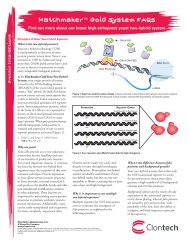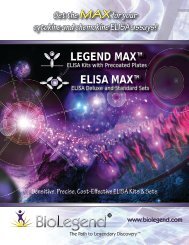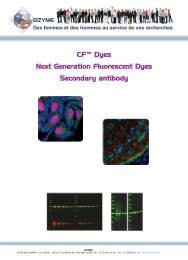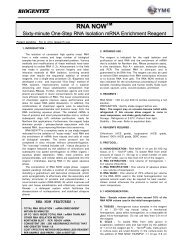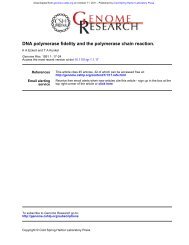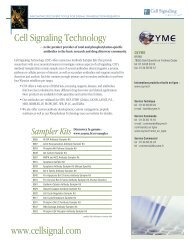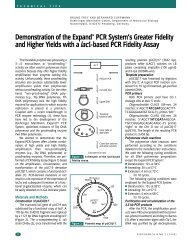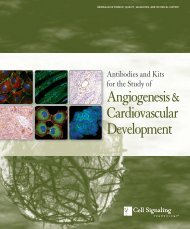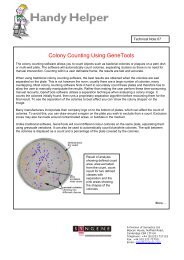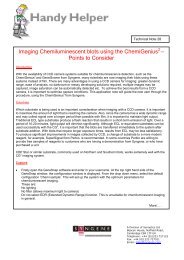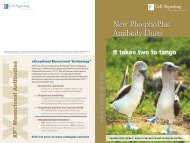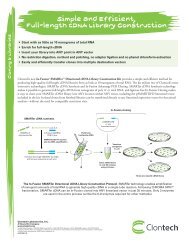Cell-based Screening Assays - Ozyme
Cell-based Screening Assays - Ozyme
Cell-based Screening Assays - Ozyme
You also want an ePaper? Increase the reach of your titles
YUMPU automatically turns print PDFs into web optimized ePapers that Google loves.
<strong>Cell</strong>ular Analysis Tools<br />
Cyclic AMP and Cyclic GMP XP ® Assay Kits<br />
Cyclic AMP and Cyclic GMP XP ® Assay Kits (#4339 and<br />
#4360) are <strong>based</strong> on the competition immunoassay principle and<br />
can be used to measure the activation of many G protein-coupled<br />
receptors (GPCRs). Kits using a chemiluminescent option are also<br />
available (#8019 and #8020). In these kits, cyclic nucleotide<br />
in the sample of interest competes with a fixed amount of cyclic<br />
nucleotide-HRP conjugate provided in the kit for binding to<br />
cyclic nucleotide-specific XP ® rabbit monoclonal antibody that is<br />
precoated on the assay plate. Because of the competitive nature of<br />
this assay, the magnitude of the absorbance is inversely proportional<br />
to the quantity of cyclic nucleotide in the sample.<br />
:: Highest quality XP monoclonal antibodies employed in the assay<br />
ensure the greatest possible sensitivity and specificity.<br />
:: Technical support is provided by the scientists who designed and<br />
produce these products and know them best.<br />
RLU (x10 6 )<br />
5<br />
4<br />
3<br />
2<br />
1<br />
0<br />
-5<br />
-4 -3 -2 -1 0 1 2 3<br />
Log (FSK, µM)<br />
110<br />
90<br />
70<br />
50<br />
30<br />
10<br />
-5<br />
-4 -3 -2 -1 0 1 2 3<br />
Log (FSK, µM)<br />
Cyclic AMP XP ® Chemiluminescent Assay Kit #8019: Treatment of CHO cells with Forskolin (FSK)<br />
#3828 increases cAMP concentration as detected by #8019. CHO cells were seeded at 4x10 4 cells/<br />
well in a 96-well plate and incubated overnight. <strong>Cell</strong>s were pretreated with 0.5 mM IBMX (30 min)<br />
prior to FSK treatment (15 min) and lysed with 1X <strong>Cell</strong> Lysis Buffer #9803. The light emission values<br />
(left) and percentage of activity (right) are shown. The percentage of activity is calculated as follows:<br />
% activity =100X[(RLU-RLU basal<br />
)/(RLU max<br />
-RLU basal<br />
)], where RLU is the sample relative light unit, RLU max<br />
is the light emission at maximum stimulation (i.e. high FSK concentration), and RLU basal<br />
is the light<br />
emission at basal level (no FSK). FSK directly activates adenylyl cyclases and increases cellular cAMP<br />
concentration. IBMX is a non-specific inhibitor of cAMP and cGMP phosphodiesterases and promotes<br />
accumulation of cAMP and cGMP in cells.<br />
% Activity<br />
NEW XTT <strong>Cell</strong> Viability Kit<br />
The XTT <strong>Cell</strong> Viability Kit #9095 offers a simple means of<br />
performing drug discovery compound screens and toxicity studies.<br />
In this kit, cellular metabolism is monitored through cellular<br />
dehydrogenase-mediated enzymatic reduction of the tetrazolium salt<br />
XTT to a colored formazan dye. Metabolically active cells are capable<br />
of reducing XTT to a colored dye, and hence, the proportion of dye<br />
quantified by measuring absorbance at 450 nm is proportional to the<br />
number of viable cells in a sample.<br />
Absorbance<br />
450nm<br />
3.5<br />
3.0<br />
2.5<br />
2.0<br />
1.5<br />
1.0<br />
0.5<br />
BrdU<br />
XTT<br />
XTT <strong>Cell</strong> Viability Kit #9095: HeLa cells were seeded at 1x10 4 cells/well in a 96-well plate and incubated<br />
overnight. <strong>Cell</strong>s were then treated with various concentrations of Staurosporine #9953 overnight. The<br />
cytotoxicity was measured using #9095 (red) and BrdU <strong>Cell</strong> Proliferation Assay Kit #6813 (blue) as<br />
shown in the left panel. The percent inhibition in each assay was calculated and plotted in the right panel.<br />
Staurosporine is a nonspecific kinase inhibitor and induces cellular apoptosis.<br />
% Inhibition<br />
0<br />
0<br />
-3 -2 -1 0 1 2 -3 -2 -1 0 1 2<br />
Log (Staurosporine, µM)<br />
Log (Staurosporine, µM)<br />
120<br />
100<br />
80<br />
60<br />
40<br />
20<br />
BrdU<br />
XTT<br />
BrdU <strong>Cell</strong> Proliferation Assay Kit<br />
The BrdU <strong>Cell</strong> Proliferation Assay Kit #6813 is a plate-<strong>based</strong><br />
immunoassay that provides a straight forward means of assaying<br />
fundamental cellular activity. This kit offers an accurate, sensitive,<br />
and direct readout of cell division unattainable with viability dyes.<br />
:: Ability to interface with microplate environment, allowing higher<br />
throughput.<br />
:: Elimination of the need for microscopy, yielding results without<br />
specialized equipment.<br />
:: Elimination of the need for radioactive isotope labeling, providing<br />
a safer and simpler protocol.<br />
Absorbance<br />
450nm<br />
4<br />
3<br />
2<br />
1<br />
0<br />
0.001 0.01 0.1 1 10 100<br />
hEGF (ng/ml)<br />
BrdU <strong>Cell</strong> Proliferation Assay<br />
Kit #6813: Treatment of MCF 10A<br />
cells with Human Epidermal Growth<br />
Factor (hEGF) #8916 increases cell<br />
proliferation as detected by #6813.<br />
MCF 10A cells were seeded at<br />
1x10 4 cells/well in a 96-well plate<br />
and incubated overnight. <strong>Cell</strong>s were<br />
then starved in serum-free medium<br />
overnight. hEGF was added to the<br />
plate and cells were incubated for 24<br />
hr. Finally, 10 μM BrdU was added to<br />
the plate and cells were incubated<br />
for 4 hr.<br />
UNPARALLELED PRODUCT QUALITY, VALIDATION, AND TECHNICAL SUPPORT<br />
9



